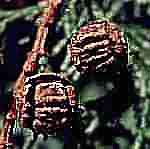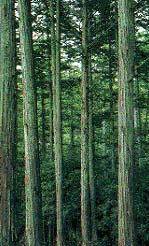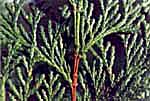Conservation Status

Chamaecyparis obtusa
(Siebold et Zuccarini) Endlicher 1847
Common names
ヒノキ hinoki [Japanese]; hinoki cypress; var. formosana is called 黃檜 huang kuai "yellow cypress", 臺灣黃檜 taiwan huang kuai, "Taiwan yellow cypress", 台灣扁柏 taiwan bian bo, 厚殼 hou ke "thick bark" [Chinese].
Taxonomic notes
Syn: Retinospora obtusa Sieb. & Zucc. 1870 (Silba 1986).
One variety, formosana (Hayata) Rehder 1914, synonyms for which include C. obtusa Sieb. & Zucc. forma formosana Hayata 1908; and C. taiwanensis Masamune & Suzuki 1923. The difference between the variety and the type is nearly as great as the difference between Ch. pisifera and Ch. formosensis, and it similarly differs in climatic and ecological adaptation; it may be better treated at specific or at least subspecific rank.
Description
Trees to 40 m high and 3 m in diameter, the trunk straight, bark reddish brown, fibrous, fissured into thin strips. Branchlets slender, closely arranged in one horizontal plane. Leaves subulate on seedlings, then scale-like, densely imbricate, closely appressed, dark green above, with white marks beneath, the apex obtuse, often keeled. Mature cones globose, 8-12 mm in diameter, the scales 8-10, each scale smoothly rounded and minutely mucronate, the apical pair of scales fused. Seeds about 3 mm long, narrowly winged, about 4 mm in diameter (M.P. Frankis e-mail 1999.02.03, Li 1975, Walker 1976). The var. formosana differs in smaller cones, 7-9 mm, and scales with a small central depression (M.P. Frankis email 1999.02.03). See García Esteban et al. (2004) for a detailed characterization of the wood anatomy.
Distribution and Ecology
Southern Japan (Walker 1976). Hardy to Zone 6 (cold hardiness limit between -23.2°C and -17.8°C) (Bannister and Neuner 2001). The variety in Taiwan, hardiness Zone 8.
Var. formosana reported for Taiwan: Hualien, Ilan and Xinchu Xians, esp. Yuanyanghu (Lake) Nature Preserve (121:24E, 24:35N). Elevation 1600-2900 m. Mesic mixed Chamaecyparis and broad-leaved forest; also exposed sites at high elevation (HAST 1999).
Remarkable Specimens
The oldest known specimen, 1101 years, is documented in a tree-ring chronology covering the period 907-2007 (fully crossdated), collected near Cilan, Taiwan, by William E. Wright and colleagues (doi.org/10.25921/xjz3-9r06). The 1101-year lifespan was shown in one living tree. The chronology was used in at least one paleoclimate study (Cook et al. 2010). Besides this, Suzuki (1997) studied this species on Yakushima Island. The oldest trees he found were only about 300 years, but he cites Kawada (1933) as having found a tree stump with 1065 rings at 30.333°N, 130.500°E on Yakushima. Extensive logging occurred on Yakushima in the 18th and 19th Centuries, and hinoki stumps from those days are likely still relatively intact. Var. formosana also exceeds 1,000 years of age (Grissino-Mayer 2010).
Ethnobotany
Hinoki means "fire tree"; it was used to make fire by friction, a practice still employed at Shinto shrines (Walker 1976).
It is one of the 'Five sacred Trees of Kiso' in Japan, the others being Ch. pisifera, Thuja standishii, Thujopsis dolabrata and Sciadopitys verticillata (Dallimore et al. 1967).
Historically, this has been one of the most important species used in Japanese architecture. During the Nara period (8th Century) it and Sciadopitys verticillata accounted for the majority of structural wood recovered in archeological investigations. By the Muromachi period (14th to 16th Centuries) and the Edo period (1603-1867), the structural emphasis had shifted to use of Pinus densiflora and Pinus thunbergii, but surviving structures still contain a great deal of C. obtusa (Takao 2004).
The gate shown at right is a 4/5-scale replica of the Kara Gate at Nishi Hongan-Ji Temple in Kyoto. Made of hinoki with a traditional copper roof, it was built in 1910 and reconstructed in 1994, thereby constituting an example not only of the use of hinoki in traditional Japanese architecture, but also of the Japanese penchant for reconstructing their deteriorating historical structures in exact detail, so that an ancient building may not contain any ancient wood.
Observations
Remarks
The epithet obtusa refers to the obtuse leaf apices.
Citations
Cook, E. R., K. J. Anchukaitis, B. M. Buckley, R. D. D'Arrigo, G. C. Jacoby, and W. E. Wright. 2010. Asian monsoon failure and megadrought during the last millennium. Science 328(5977):486-489, DOI: 10.1126/science.1185188.
Forestry and Forest Products Research Institute (FFPRI). 1996. Introduction to Forestry And Forest Products Research Institute. http://ss.ffpri.affrc.go.jp/outline.html, accessed 1998.10.12, now defunct.
Grissino-Mayer, H. 2010. Trees Gallery. http://web.utk.edu/~grissino/trees%20gallery.htm, accessed 2012.10.09, now defunct.
Herbarium of the Research Center For Biodiversity, Academia Sinica, Taipei [HAST]. 1999. Database output at http://www2.sinica.edu.tw:8080/hast/eindex.html, accessed 1999.03.15, now defunct.
Kawada. 1933. A Chamaecyparis obtusa stump more than one thousand years old. Plant and Animal 1:1358-1359 [in Japanese].
Suzuki, Eizi. 1997. The dynamics of old Cryptomeria japonica forest on Yakushima Island. Tropics 6(4):421-428.
Takao, Itoh. 2004. Architectural development of the Japanese house and wood species used for construction. http://www.nara.accu.or.jp/elearning/2004/architectural.pdf, accessed 2009.08.24, now defunct.
This page co-edited with M.P. Frankis, 1999.02.
See also
Elwes and Henry 1906-1913 at the Biodiversity Heritage Library (as Cupressus obtusa). This series of volumes, privately printed, provides some of the most engaging descriptions of conifers ever published. Although they only treat species cultivated in the U.K. and Ireland, and the taxonomy is a bit dated, still these accounts are thorough, treating such topics as species description, range, varieties, exceptionally old or tall specimens, remarkable trees, and cultivation. Despite being over a century old, they are generally accurate, and are illustrated with some remarkable photographs and lithographs.
Farjon (2005).
Huang 1994 (the Flora of Taiwan).
Threatened Conifers of the World.





